
LOADING ...
In response to evolving domestic opinion, eMedals Inc has made the conscious decision to remove the presentation of German Third Reich historical artifacts from our online catalogue. For three decades, eMedals Inc has made an effort to preserve history in all its forms. As historians and researchers, we have managed sensitive articles and materials with the greatest of care and respect for their past and present social context. We acknowledge the growing sentiments put forth by the Canadian public and have taken proactive actions to address this opinion.
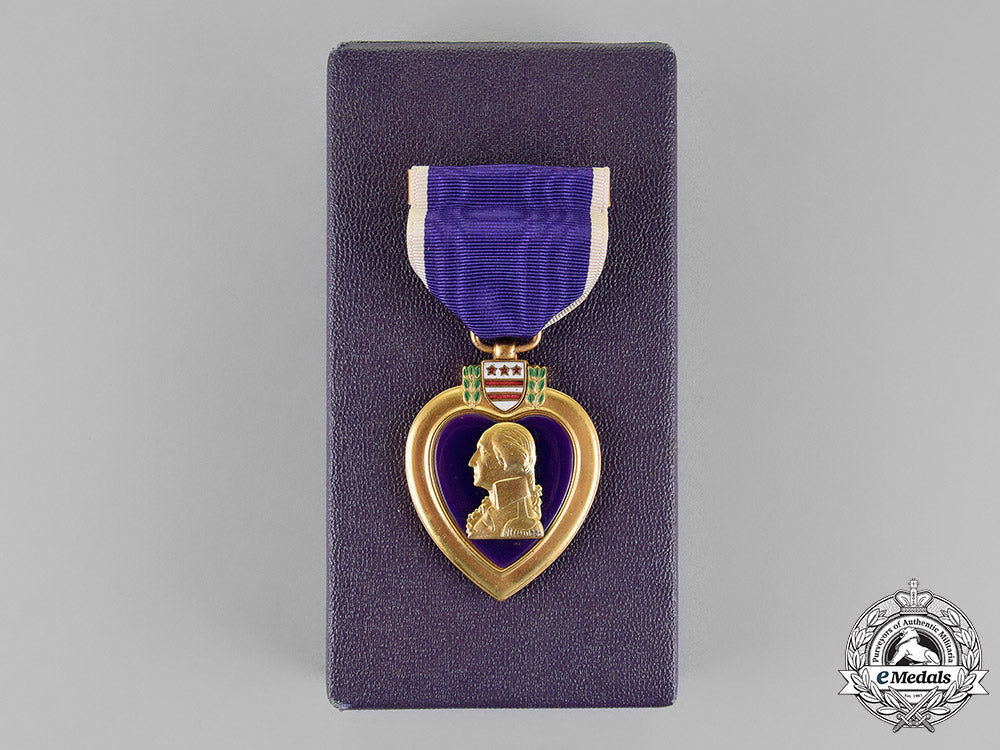
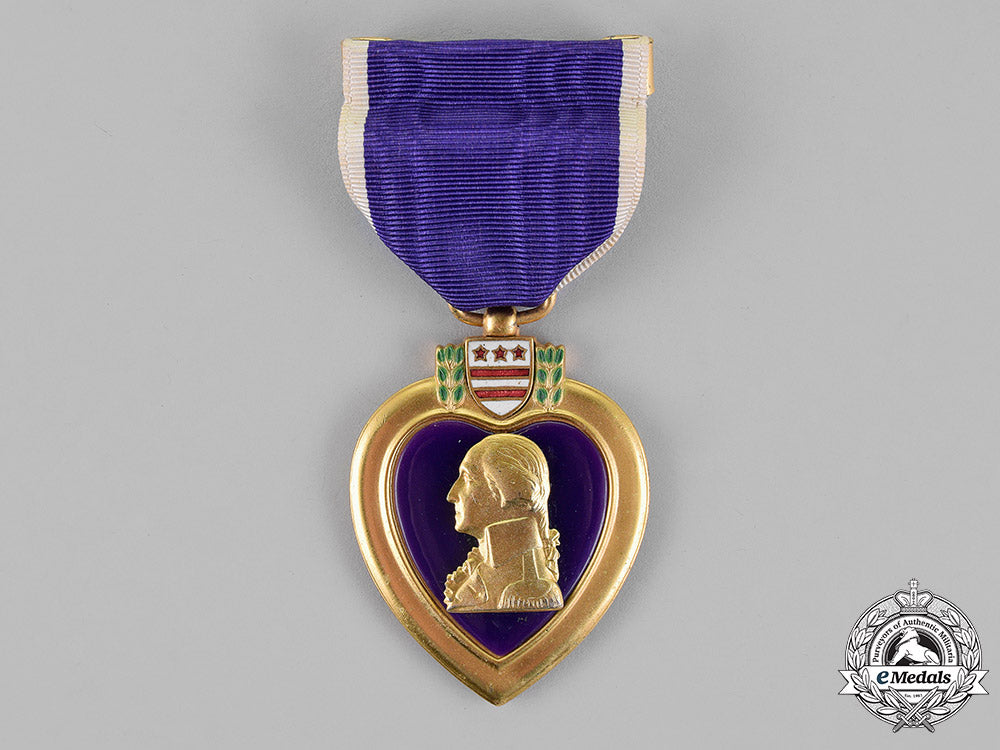
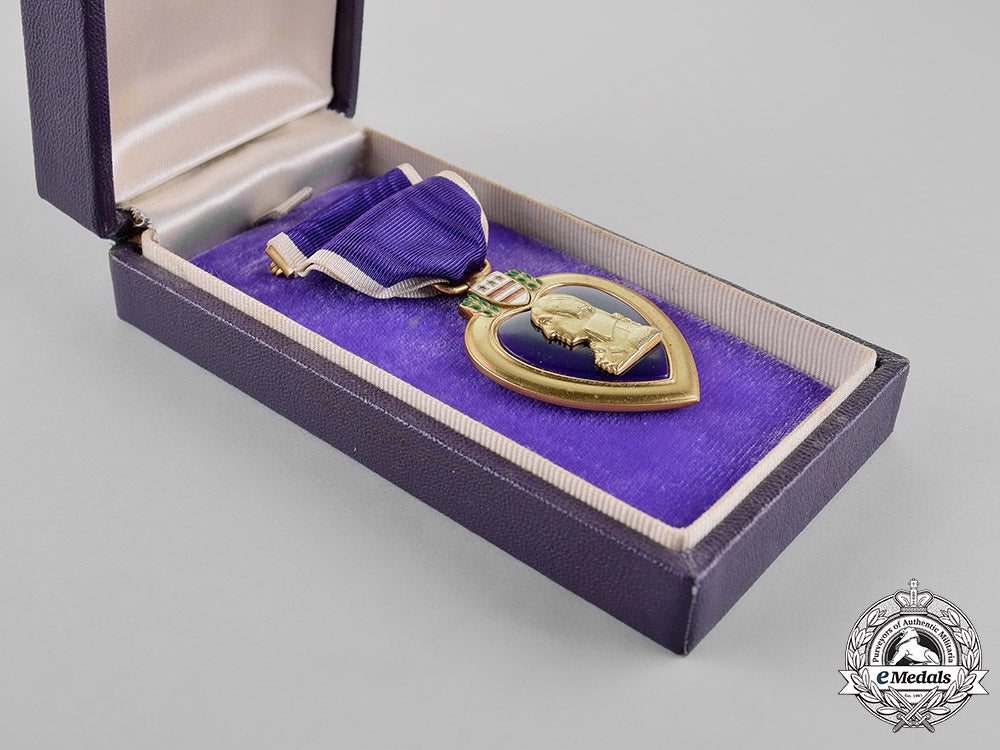
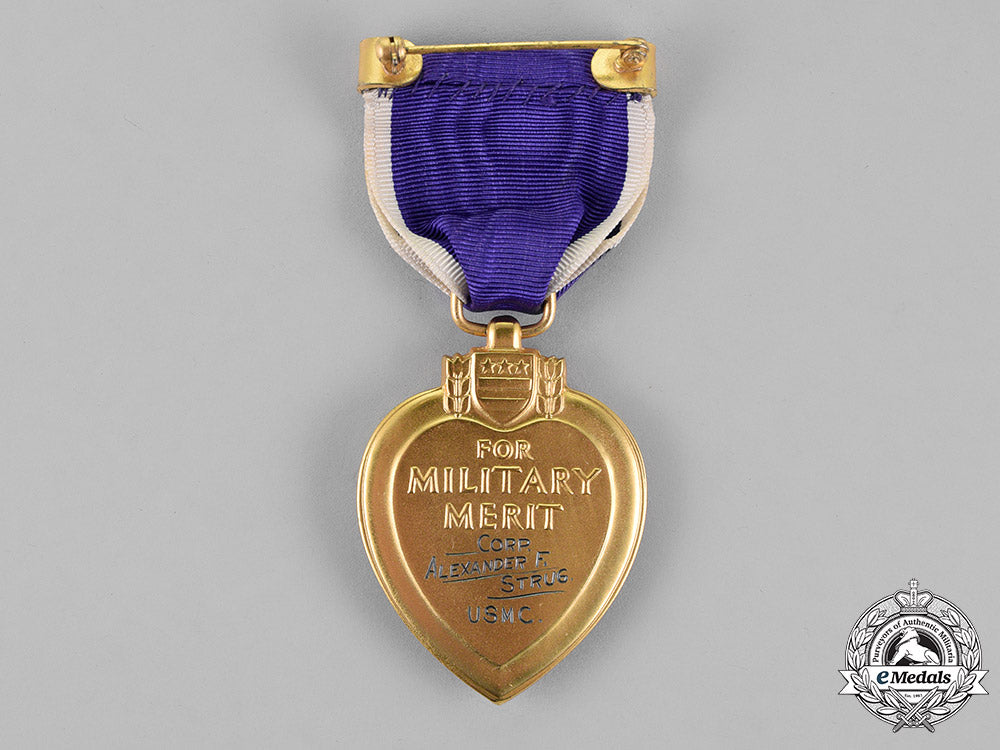
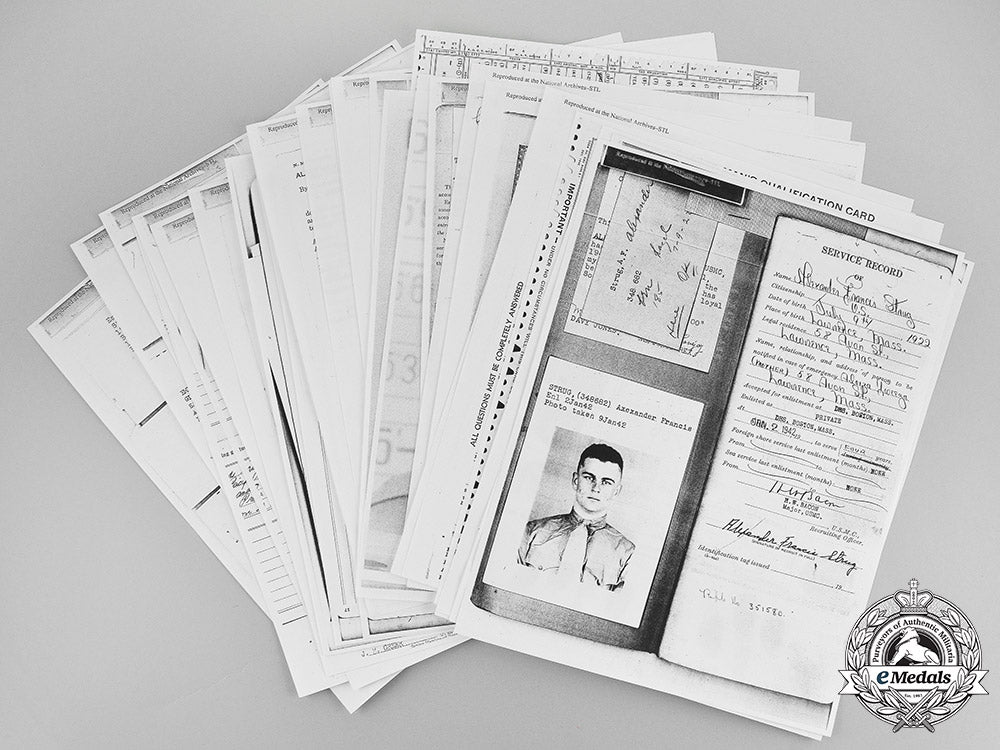
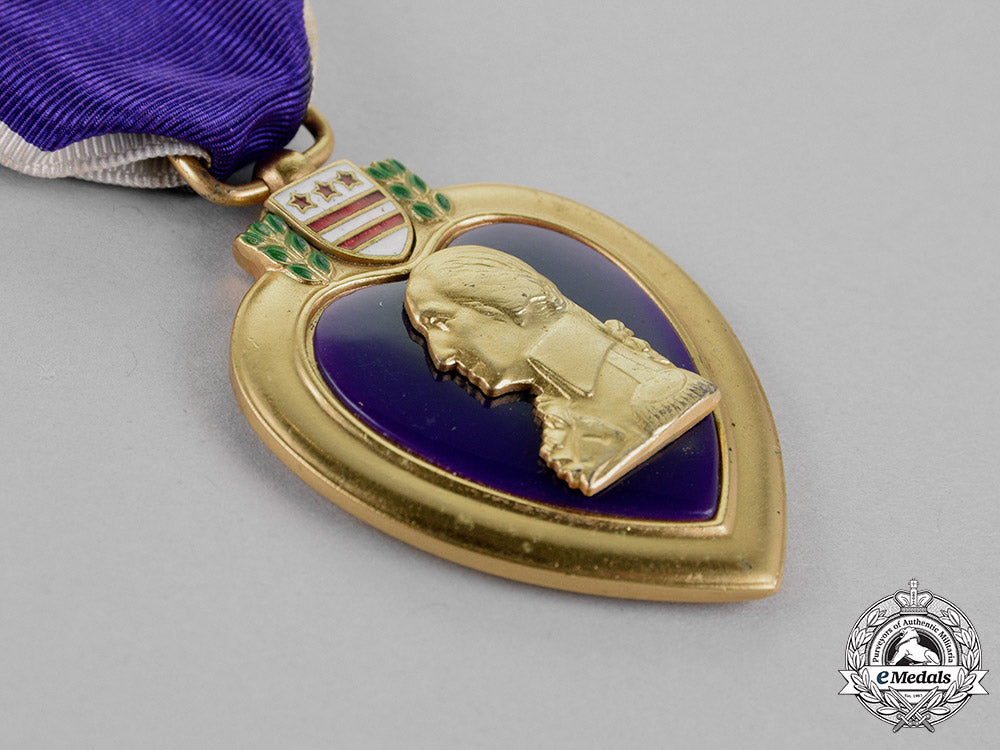
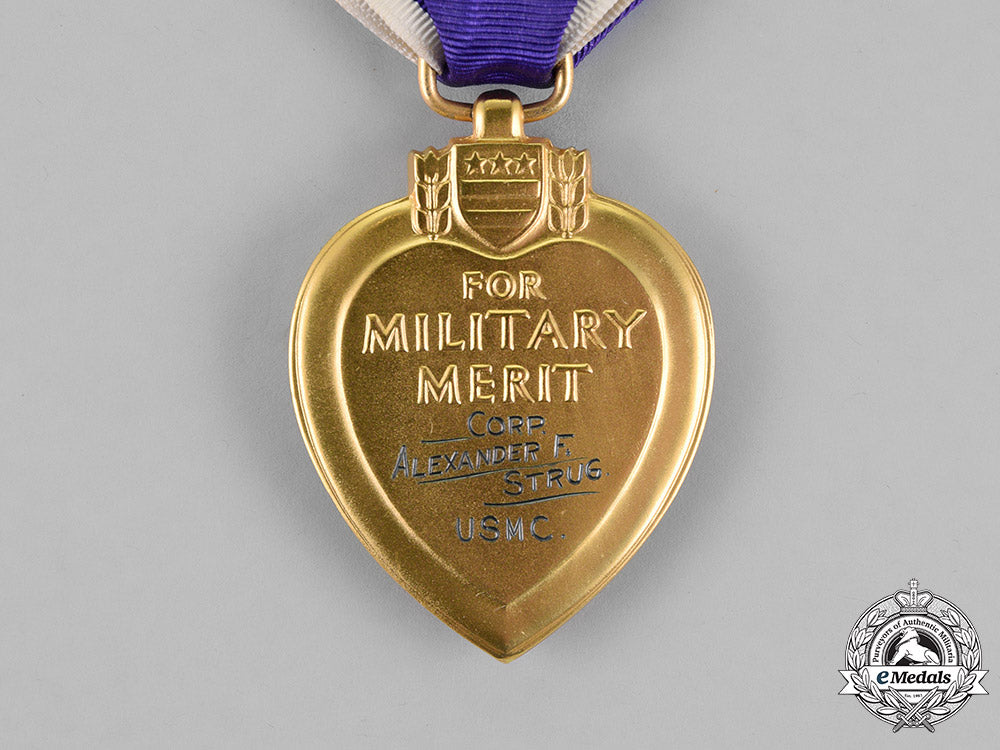
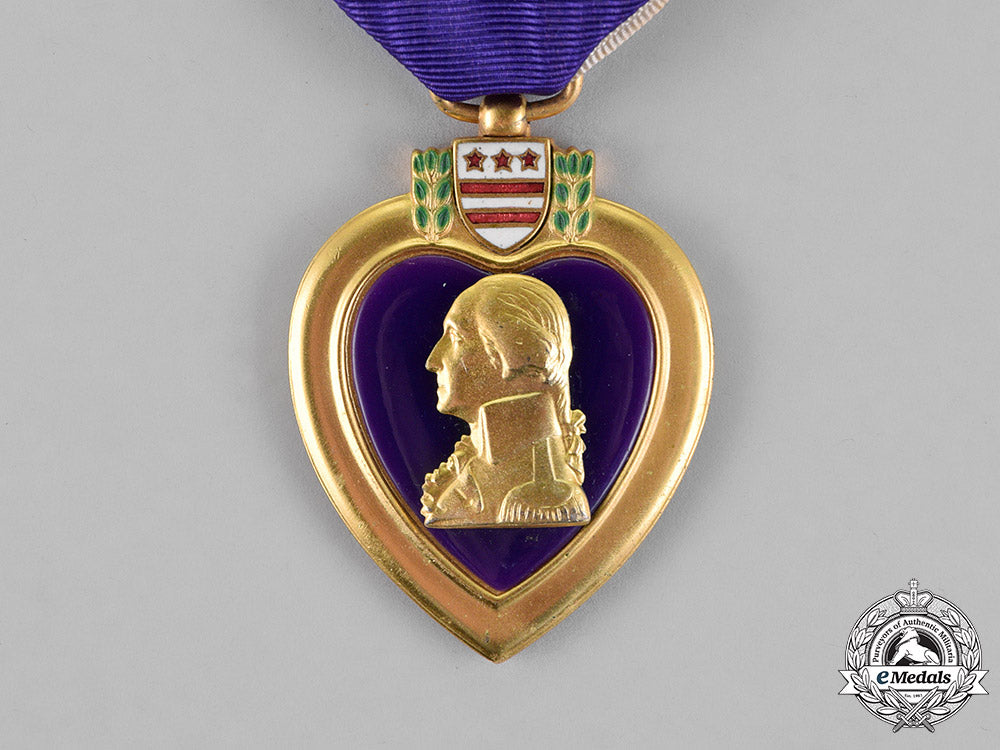
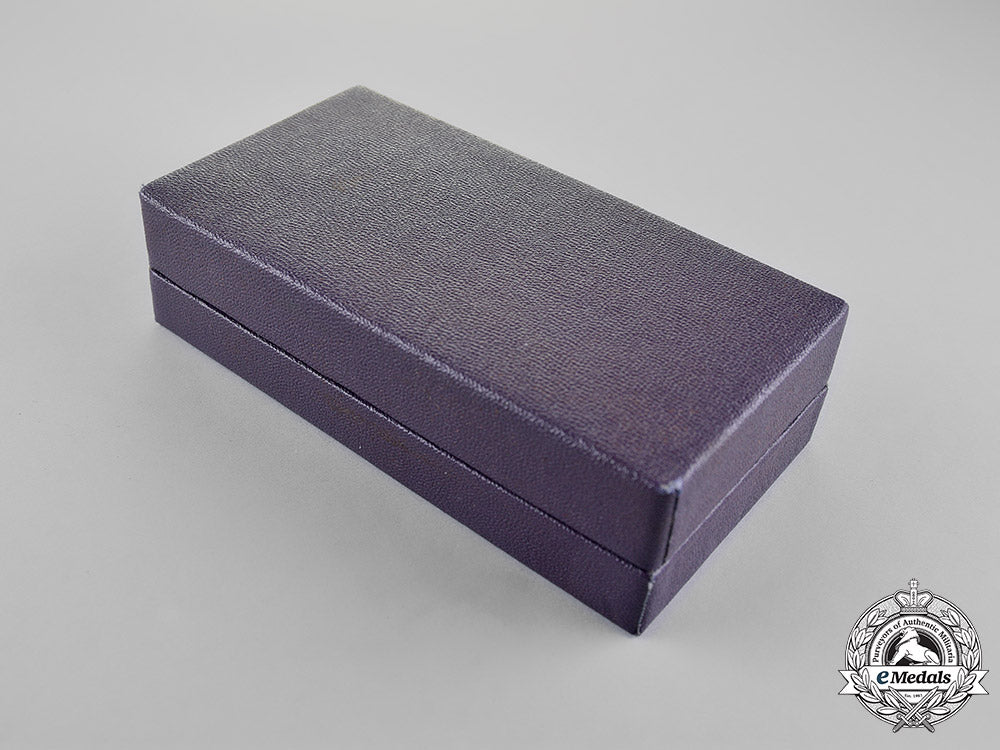
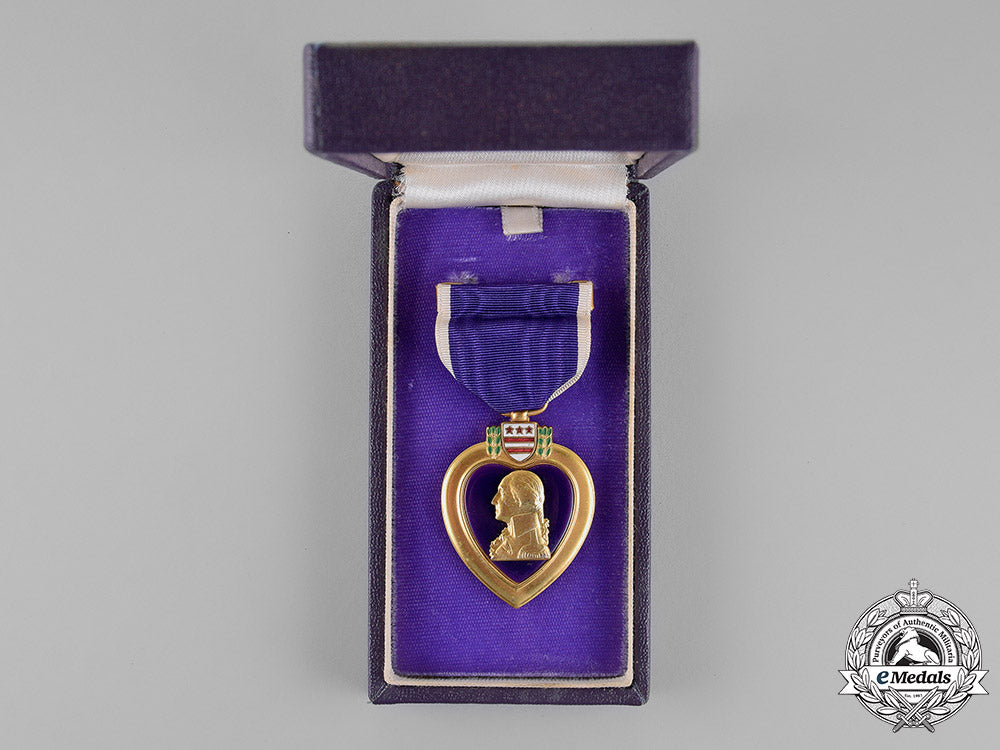
United States. A Purple Heart To Corporal Strug, 1St Marine Division, Battle Of Cape Gloucester, Wia, 1943
United States. A Purple Heart To Corporal Strug, 1St Marine Division, Battle Of Cape Gloucester, Wia, 1943
SKU: ITEM: AZ039
Current Bid:
Your Max Bid:
Bid History:
Time Remaining:
Couldn't load pickup availability
Shipping Details
Shipping Details
eMedals offers rapid domestic and international shipping. Orders received prior to 12:00pm (EST) will be shipped on the same business day.* Orders placed on Canadian Federal holidays will be dispatched the subsequent business day. Courier tracking numbers are provided for all shipments. All items purchased from eMedals can be returned for a full monetary refund or merchandise credit, providing the criteria presented in our Terms & Conditions are met. *Please note that the addition of a COA may impact dispatch time.
Shipping Details
eMedals offers rapid domestic and international shipping. Orders received prior to 12:00pm (EST) will be shipped on the same business day.* Orders placed on Canadian Federal holidays will be dispatched the subsequent business day. Courier tracking numbers are provided for all shipments. All items purchased from eMedals can be returned for a full monetary refund or merchandise credit, providing the criteria presented in our Terms & Conditions are met. *Please note that the addition of a COA may impact dispatch time.
Description
Description
Two-piece construction, in sterling silver gilt with purple and white enamels, engraved "CORP. ALEXANDER F. STRUG. USMC." on the reverse, measuring 35 mm (w) x 43.5 mm (h), original ribbon with brooch pinback, intact enamels, in its hardshelled "coffin-style" case of issue, extremely fine. Accompanied by copies of his Service Records.
Footnote: Alexander Francis Strug was born on July 9, 1922 in Lawrence, Massachusetts. His father was born in Russia and his mother was born in Poland. His mother, Aloiza, later re-married Stanley Tweega, the latter becoming Strug's stepfather. Strug grew up in Lawrence, Massachusetts, where he attended eight years of grammar school, graduating in 1935 and four years of high school, graduating in 1939. After high school, he took one year of Physics and one year of General Science at the college level. He then worked as a Driver for the Cooper Dairy Company in Salem, New Hampshire, operating a two-ton truck engaged in delivering milk over an established route, traveling forty miles each day and also helping to carry milk to the houses, his last day of employment stated as November 15, 1941. Strug enlisted as a Private (348682) for four years' service with the United States Marine Corps at the Recruiting Depot in Boston, Massachusetts, on January 2, 1942. He was transferred on January 4th to the Marine Corps Recruit Depot at Parris Island, South Carolina, where he was posted to the 6th Recruit Battalion and it was here that he qualified in bayonet. He was transferred to Quantico, Virginia, where he joined Company "F" Training Center on January 24th, then joined Company "F", 2nd Battalion, 7th Marines, Fleet Marine Force in New River, North Carolina, on February 8th. Private Strug embarked the Army Base Depot at Norfolk, Virginia aboard the Heywood-class attack transport USS Heywood (APA-6) on April 2, 1942, sailing on April 10th. It was during this time that Strug was promoted to the rank of Private First Class on April 15, 1942 and assigned to "Line Duty". He is documented as being with the Second Battalion, Seventh Marines (Reinforced), First Marine Division, Fleet Marine Force, arriving at "Strawhat" (the code name for Upolu, Western Samoa, which was administered at the time by New Zealand) and disembarked on May 8th. Private First Class Strug embarked Apia, Upolu, Western Samoa aboard the President Jackson-class attack transport USS President Hayes (APA-20) on August 28, 1942, arriving in Pago Pago, Tutuila, American Samoa the same day. One week later, still aboard the USS President Hayes, he sailed from Pago Pago on September 4th, arriving in Tonga Tabu, Friendly Islands on September 7th. He departed Tongu Tabu on September 9th, arriving in Espiritu Santo, New Hebrides (now Vanuatu) on September 12th. After five days in Espiritu Santo, he sailed September 14th for service in the Solomon Islands, arriving in Guadalcanal, Solomon Islands on September 18th. It was here that Private First Class Strug was to be a participant in the Battle of Guadalcanal (code named Operation Watchtower by American forces), a military campaign fought between August 7, 1942 and February 9, 1943 on and around the island of Guadalcanal. Strug was subjected to enemy naval gun fire on September 18th and participated in engagement with Japanese forces on October 7th, 8th and 9th.
Four days later, he was subjected to enemy naval gun fire on October 13th, 14th and 15th. This was followed ten days later by his participation in engagement with the enemy that would last on-and-off over the next sixteen days, entailing six encounters: October 25th and 26th, November 1st, 3rd, 9th and 10th. It was for his efforts during the Battle of Guadalcanal that he would earn a Battalion Citation from A.A. Vandergrift, on November 1, 1942. Strug was promoted to the rank of Corporal on February 1, 1943, with effective from October 27, 1942 and assigned to "Communication Duty". Three days later, he received a Presidential Citation from Frank Knox, 1st Marine Division, Reinforcement, on February 4, 1943. After his harrowing times at Guadalcanal, he embarked for the nearby safety of Australia. Corporal Strug embarked Melbourne, Victoria, Australia aboard the HMAS Mangoria on April 21, 1943, for Special Landing Exercises on the coast of Victoria, arriving at Dromana, Victoria on April 25th. Five months later, he embarked Melbourne aboard the SS Rachel Jackson on September 20, 1943, arriving in Townsville, Queensland, Australia on September 22nd. The SS Rachel Jackson was part of the United States Maritime Service and was pressed into service in the Pacific theater, hauling essential supplies to places such as Port Moresby, Guadalcanal and the Philippines, as well as troop transfers. One week after arriving in Townsville, Corporal Strug sailed on September 28th, arriving in Milne Bay, New Guinea on October 1st, which was followed by his departure the same day for Oro Bay, New Guinea, arriving on October 2nd. Shortly thereafter, he made his way to the Samboga Staging Area at nearby Cape Sudest in Papua, Northern British New Guinea and embarked aboard Infantry Landing Crafts on October 27th, for Special Landing Exercises at nearby Taupota Bay, disembarking on October 29th. Over a period on ten weeks, while assigned to camp at the Samboga Staging Area at Cape Sudest, he was subjected to Japanese aerial activity and bombardment on twenty-one occasions: October 9th, 10th, 11th, 13th, 14th, 15th, 17th, 24th, 27th, 28th, 29th and 31st, November 2nd, 9th, 11th, 15th, 22nd and 23rd, December 5th, 11th and 19th. After a tense twelve weeks, Corporal Strug embarked the Samboga Staging Area at Cape Sudest aboard Infantry Landing Crafts on December 24, 1943, his next destination to be Cape Gloucester, New Britain. At Cape Gloucester, Corporal Strug was destined to participate in the assault landing against enemy positions on December 26th, which was to be followed by the seizure, occupation and defense of a beachhead about 1,000 yards northwest of Silimati Point, Cape Gloucester on December 26th and 27th, 1943. The Battle of Cape Gloucester was fought between Japanese and Allied forces on the island of New Britain between late December 1943 and April 1944. The battle was part of Operation Cartwheel, the main Allied strategy in the South West Pacific Area and Pacific Ocean Areas during 1943-1944 and was the second landing of the war by the United States 1st Marine Division, after Guadalcanal. The objective of the operation was to capture the two Japanese airfields near Cape Gloucester. The main landing came on December 26th, when United States Marines landed on either side of the peninsula. The western landing force cut the coastal road, while the main force, landing on the eastern side, advanced north towards the airfields. The advance met light resistance at first but was slowed by the swampy terrain. A Japanese counterattack briefly slowed the advance but by December 30th, the airfields had been captured and consolidated by the Marines. Fighting continued into early January 1944 as American troops extended their perimeter south from the airfields, with mopping up operations in the vicinity continuing into April 1944. However, Corporal Strug's participation against the Japanese would cease as of December 27, 1943, as he was Wounded in Action, suffering a gunshot wound to his left arm, incurred by enemy rifle fire. Emergency treatment was administered in the field, which was followed by his evacuation from Cape Gloucester aboard an Infantry Landing Craft on December 28th, arriving at Oro Bay on December 29th. He was admitted to the 362nd Stationary Hospital on December 29th, where he was declared to be "in seriously ill condition". He was evacuated for further hospitalization on January 5, 1944 and admitted to United States Navy Mobile Hospital No. 10, Navy 135. It was here that he was assessed with paralysis of the median and ulnar nerves in his left arm, as the result of the gunshot wound.
He had a dense wide scar on the medial surface of the distal third of the left arm, otherwise, his physical findings were "normal". His mother, Aloiza Tweega, was informed of the injury to her son, in a letter dated January 21, 1944, from Second Lieutenant M.G. Craig, USMC. Five weeks after arriving at United States Navy Mobile Hospital No. 10, his condition necessitated his return to the United States. Corporal Strug sailed from Brisbane, Queensland, Australia aboard the troop transport ship USAT Noordam on February 10, 1944. The USAT Noordam was the largest ship owned by Holland America Line (the Netherlands) and was considered to be their greatest liner. In 1940, she had been take out of service on the Trans-Atlantic route due to the war and was transferred to the Java-New York Line, to operate on the Dutch East Indies (Indonesia) service. Due to the war in the Pacific, she was re-equipped and looked anything but a luxury liner. She was very fast and due to the speed of the ship, it did not have the usual naval ships protecting her, even though they were carrying several hundred troops. Corporal Strug disembarked in San Francisco, California on February 29, 1944 and was admitted to the United States Naval Hospital at Mare Island, California for the paralysis of the median and ulnar nerves in his left arm. Three weeks after his admission to hospital, a surgical procedure was performed on his arm on March 20, 1944. A plastic repair of the scarred area was done in conjunction with an excision of a neuroma of the median and ulnar nerve and suture of these nerves. Some improvement followed, but there was a neroma of the left ulnar nerve at the elbow. This neroma had been previously excised on October 12, 1944, the nerve sutured and transplanted anteriorly. It was also noted by the physician at Mare Island, that while in hospital overseas, that Corporal Strug had had two episodes of Malaria. A slight improvement in the median nerve was noted but very little, if any, in the ulnar nerve. There was palsy in the ulnar nerve, with marked weakness in median nerve function, the fingers of his left hand now "somewhat stiffened". It was the "opinion of the Medical Board that maximum benefit has been obtained from hospitalization and that further treatment will not enable him to return to a useful duty status". He was declared "Unfit for Service" and that his debility would be "Permanent". The Board recommended "That he be discharged from the United States Marine Corps". Strug indicated that if he was discharged, that he intended to return to school. Corporal Alexander Francis Strug, United States Marine Corps was Honorably Discharged at Mare Island, California on February 14, 1945. He was awarded a Certificate of Satisfactory Service and subsequently filed a Pension Claim.
Description
Two-piece construction, in sterling silver gilt with purple and white enamels, engraved "CORP. ALEXANDER F. STRUG. USMC." on the reverse, measuring 35 mm (w) x 43.5 mm (h), original ribbon with brooch pinback, intact enamels, in its hardshelled "coffin-style" case of issue, extremely fine. Accompanied by copies of his Service Records.
Footnote: Alexander Francis Strug was born on July 9, 1922 in Lawrence, Massachusetts. His father was born in Russia and his mother was born in Poland. His mother, Aloiza, later re-married Stanley Tweega, the latter becoming Strug's stepfather. Strug grew up in Lawrence, Massachusetts, where he attended eight years of grammar school, graduating in 1935 and four years of high school, graduating in 1939. After high school, he took one year of Physics and one year of General Science at the college level. He then worked as a Driver for the Cooper Dairy Company in Salem, New Hampshire, operating a two-ton truck engaged in delivering milk over an established route, traveling forty miles each day and also helping to carry milk to the houses, his last day of employment stated as November 15, 1941. Strug enlisted as a Private (348682) for four years' service with the United States Marine Corps at the Recruiting Depot in Boston, Massachusetts, on January 2, 1942. He was transferred on January 4th to the Marine Corps Recruit Depot at Parris Island, South Carolina, where he was posted to the 6th Recruit Battalion and it was here that he qualified in bayonet. He was transferred to Quantico, Virginia, where he joined Company "F" Training Center on January 24th, then joined Company "F", 2nd Battalion, 7th Marines, Fleet Marine Force in New River, North Carolina, on February 8th. Private Strug embarked the Army Base Depot at Norfolk, Virginia aboard the Heywood-class attack transport USS Heywood (APA-6) on April 2, 1942, sailing on April 10th. It was during this time that Strug was promoted to the rank of Private First Class on April 15, 1942 and assigned to "Line Duty". He is documented as being with the Second Battalion, Seventh Marines (Reinforced), First Marine Division, Fleet Marine Force, arriving at "Strawhat" (the code name for Upolu, Western Samoa, which was administered at the time by New Zealand) and disembarked on May 8th. Private First Class Strug embarked Apia, Upolu, Western Samoa aboard the President Jackson-class attack transport USS President Hayes (APA-20) on August 28, 1942, arriving in Pago Pago, Tutuila, American Samoa the same day. One week later, still aboard the USS President Hayes, he sailed from Pago Pago on September 4th, arriving in Tonga Tabu, Friendly Islands on September 7th. He departed Tongu Tabu on September 9th, arriving in Espiritu Santo, New Hebrides (now Vanuatu) on September 12th. After five days in Espiritu Santo, he sailed September 14th for service in the Solomon Islands, arriving in Guadalcanal, Solomon Islands on September 18th. It was here that Private First Class Strug was to be a participant in the Battle of Guadalcanal (code named Operation Watchtower by American forces), a military campaign fought between August 7, 1942 and February 9, 1943 on and around the island of Guadalcanal. Strug was subjected to enemy naval gun fire on September 18th and participated in engagement with Japanese forces on October 7th, 8th and 9th.
Four days later, he was subjected to enemy naval gun fire on October 13th, 14th and 15th. This was followed ten days later by his participation in engagement with the enemy that would last on-and-off over the next sixteen days, entailing six encounters: October 25th and 26th, November 1st, 3rd, 9th and 10th. It was for his efforts during the Battle of Guadalcanal that he would earn a Battalion Citation from A.A. Vandergrift, on November 1, 1942. Strug was promoted to the rank of Corporal on February 1, 1943, with effective from October 27, 1942 and assigned to "Communication Duty". Three days later, he received a Presidential Citation from Frank Knox, 1st Marine Division, Reinforcement, on February 4, 1943. After his harrowing times at Guadalcanal, he embarked for the nearby safety of Australia. Corporal Strug embarked Melbourne, Victoria, Australia aboard the HMAS Mangoria on April 21, 1943, for Special Landing Exercises on the coast of Victoria, arriving at Dromana, Victoria on April 25th. Five months later, he embarked Melbourne aboard the SS Rachel Jackson on September 20, 1943, arriving in Townsville, Queensland, Australia on September 22nd. The SS Rachel Jackson was part of the United States Maritime Service and was pressed into service in the Pacific theater, hauling essential supplies to places such as Port Moresby, Guadalcanal and the Philippines, as well as troop transfers. One week after arriving in Townsville, Corporal Strug sailed on September 28th, arriving in Milne Bay, New Guinea on October 1st, which was followed by his departure the same day for Oro Bay, New Guinea, arriving on October 2nd. Shortly thereafter, he made his way to the Samboga Staging Area at nearby Cape Sudest in Papua, Northern British New Guinea and embarked aboard Infantry Landing Crafts on October 27th, for Special Landing Exercises at nearby Taupota Bay, disembarking on October 29th. Over a period on ten weeks, while assigned to camp at the Samboga Staging Area at Cape Sudest, he was subjected to Japanese aerial activity and bombardment on twenty-one occasions: October 9th, 10th, 11th, 13th, 14th, 15th, 17th, 24th, 27th, 28th, 29th and 31st, November 2nd, 9th, 11th, 15th, 22nd and 23rd, December 5th, 11th and 19th. After a tense twelve weeks, Corporal Strug embarked the Samboga Staging Area at Cape Sudest aboard Infantry Landing Crafts on December 24, 1943, his next destination to be Cape Gloucester, New Britain. At Cape Gloucester, Corporal Strug was destined to participate in the assault landing against enemy positions on December 26th, which was to be followed by the seizure, occupation and defense of a beachhead about 1,000 yards northwest of Silimati Point, Cape Gloucester on December 26th and 27th, 1943. The Battle of Cape Gloucester was fought between Japanese and Allied forces on the island of New Britain between late December 1943 and April 1944. The battle was part of Operation Cartwheel, the main Allied strategy in the South West Pacific Area and Pacific Ocean Areas during 1943-1944 and was the second landing of the war by the United States 1st Marine Division, after Guadalcanal. The objective of the operation was to capture the two Japanese airfields near Cape Gloucester. The main landing came on December 26th, when United States Marines landed on either side of the peninsula. The western landing force cut the coastal road, while the main force, landing on the eastern side, advanced north towards the airfields. The advance met light resistance at first but was slowed by the swampy terrain. A Japanese counterattack briefly slowed the advance but by December 30th, the airfields had been captured and consolidated by the Marines. Fighting continued into early January 1944 as American troops extended their perimeter south from the airfields, with mopping up operations in the vicinity continuing into April 1944. However, Corporal Strug's participation against the Japanese would cease as of December 27, 1943, as he was Wounded in Action, suffering a gunshot wound to his left arm, incurred by enemy rifle fire. Emergency treatment was administered in the field, which was followed by his evacuation from Cape Gloucester aboard an Infantry Landing Craft on December 28th, arriving at Oro Bay on December 29th. He was admitted to the 362nd Stationary Hospital on December 29th, where he was declared to be "in seriously ill condition". He was evacuated for further hospitalization on January 5, 1944 and admitted to United States Navy Mobile Hospital No. 10, Navy 135. It was here that he was assessed with paralysis of the median and ulnar nerves in his left arm, as the result of the gunshot wound.
He had a dense wide scar on the medial surface of the distal third of the left arm, otherwise, his physical findings were "normal". His mother, Aloiza Tweega, was informed of the injury to her son, in a letter dated January 21, 1944, from Second Lieutenant M.G. Craig, USMC. Five weeks after arriving at United States Navy Mobile Hospital No. 10, his condition necessitated his return to the United States. Corporal Strug sailed from Brisbane, Queensland, Australia aboard the troop transport ship USAT Noordam on February 10, 1944. The USAT Noordam was the largest ship owned by Holland America Line (the Netherlands) and was considered to be their greatest liner. In 1940, she had been take out of service on the Trans-Atlantic route due to the war and was transferred to the Java-New York Line, to operate on the Dutch East Indies (Indonesia) service. Due to the war in the Pacific, she was re-equipped and looked anything but a luxury liner. She was very fast and due to the speed of the ship, it did not have the usual naval ships protecting her, even though they were carrying several hundred troops. Corporal Strug disembarked in San Francisco, California on February 29, 1944 and was admitted to the United States Naval Hospital at Mare Island, California for the paralysis of the median and ulnar nerves in his left arm. Three weeks after his admission to hospital, a surgical procedure was performed on his arm on March 20, 1944. A plastic repair of the scarred area was done in conjunction with an excision of a neuroma of the median and ulnar nerve and suture of these nerves. Some improvement followed, but there was a neroma of the left ulnar nerve at the elbow. This neroma had been previously excised on October 12, 1944, the nerve sutured and transplanted anteriorly. It was also noted by the physician at Mare Island, that while in hospital overseas, that Corporal Strug had had two episodes of Malaria. A slight improvement in the median nerve was noted but very little, if any, in the ulnar nerve. There was palsy in the ulnar nerve, with marked weakness in median nerve function, the fingers of his left hand now "somewhat stiffened". It was the "opinion of the Medical Board that maximum benefit has been obtained from hospitalization and that further treatment will not enable him to return to a useful duty status". He was declared "Unfit for Service" and that his debility would be "Permanent". The Board recommended "That he be discharged from the United States Marine Corps". Strug indicated that if he was discharged, that he intended to return to school. Corporal Alexander Francis Strug, United States Marine Corps was Honorably Discharged at Mare Island, California on February 14, 1945. He was awarded a Certificate of Satisfactory Service and subsequently filed a Pension Claim.










You May Also Like
Germany, HJ. A 1938 National Trade Competition Victor’s Badge, Gold Grade in Case, By Gustav Brehmer
G60096
Italy, Republic. An Order of Merit of the Italian Republic, Grand Cross Set by Johnson, 1970
EU23677
Spain, Franco Period. An Order of Civil Merit, Grand Cross Set
EU23731
Russia, Imperial. An Order of St. Anne, II Class in Gold
EU23720
Austria, Imperial. An Order of the Iron Crown, III Class in Gold, by Rothe, c.1900
EU23723
-
Germany, HJ. A 1938 National Trade Competition Victor’s Badge, Gold Grade in Case, By Gustav Brehmer
G60096
Add to CartRegular price $3,950 USDRegular price $0 USD Sale price $3,950 USDUnit price / per -
Italy, Republic. An Order of Merit of the Italian Republic, Grand Cross Set by Johnson, 1970
EU23677
Add to CartRegular price $950 USDRegular price $0 USD Sale price $950 USDUnit price / per -
Spain, Franco Period. An Order of Civil Merit, Grand Cross Set
EU23731
Add to CartRegular price $600 USDRegular price $0 USD Sale price $600 USDUnit price / per -
Russia, Imperial. An Order of St. Anne, II Class in Gold
EU23720
Add to CartRegular price $2,950 USDRegular price $0 USD Sale price $2,950 USDUnit price / per -
Austria, Imperial. An Order of the Iron Crown, III Class in Gold, by Rothe, c.1900
EU23723
Add to CartRegular price $3,950 USDRegular price $0 USD Sale price $3,950 USDUnit price / per
Do you have a similar item you are interested in selling?
Please complete the form and our client care representatives will contact you.
Sell Item
























